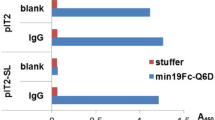Abstract
The peptide, Ala-Pro-Ala-Arg (APAR), was selected from the screening of a tetrapeptide combinatorial synthetic library as the ligand for affinity purification of an anti-Granulocyte Macrophage-Colony Stimulating Factor (GM-CSF) monoclonal antibody (Mab) developed in mouse ascitis. The affinity chromatographic matrix obtained by attachment of APAR to agarose, having a peptide density of 0.5 μmol ml−1, showed a maximum capacity of 9.1 mg Mab ml−1 and a dynamic capacity of 3.9 mg Mab ml−1. A 95% yield of electrophoretically pure anti-GM-CSF was obtained in a single step.
Similar content being viewed by others
References
Baumbach GA, Hammond DJ (1993) Protein purification using af-finity ligands deduced from peptide libraries. J. Cell. Biochem. Suppl 17A: 43.
Chase HA (1984) Prediction of the performance of preparative affinity chromatography. J. Chromatog. 297: 179–202.
Cwirla SE, Peters EA, Barrett RW, Dower WJ (1990) Peptides on phage: a vast library of peptides for identifying ligands. Proc. Natl. Acad. Sci. USA 87: 6378–6382.
Hermanson GT, Mallia KA, Smith PK (1992) Immobilization of ligands. In: Immobilized Affinity Ligand Techniques. San Diego, USA: Academic Press.
Hirabayashi Y, Fukuda H, Kimura J, Miyamoto M, Yasui K (1996) Identification of peptides mimicking the antigenicity and immunogenicity of conformational epitopes on Japanese encephalitis virus protein using synthetic peptide libraries. J. Virol. Meth. 61: 23–36.
Huang PY, Carbonell RG (1999) Affinity chromatographic screening of soluble combinatorial peptide libraries. Biotechnol. Bioeng. 63: 633–641.
Laemmli UK (1970) Cleavage of structural proteins during the assembly of the head of bacteriophage T4. Nature 22: 680–685.
Lam KS, Salmon SE, Hersh EM, Hruby VJ, Kazmierski WM(1991) A new type of synthetic peptide library for identifying ligandbinding activity. Nature 354: 82–84.
Lloyd-Williams P, Albericio F, Giralt E (1997) In: Chemical Approaches to the Synthesis of Peptides and Proteins. Boca Raton, FL: CRC Press.
Lowe CR, Pearson JC (1984) Affinity chromatography on immobilized dyes. Meth. Enzymol. 104: 97–113.
Oggero Eberhardt M, Frank R, Kratje R, Etcheverrigaray M (2003) Identification of two potential receptor-binding sites for hGM- CSF. Brazilian J. Chem. Eng. 20: 15–20.
Author information
Authors and Affiliations
Corresponding author
Rights and permissions
About this article
Cite this article
Camperi, S., Iannucci, N., Albanesi, G. et al. Monoclonal antibody purification by affinity chromatography with ligands derived from the screening of peptide combinatory libraries. Biotechnology Letters 25, 1545–1548 (2003). https://doi.org/10.1023/A:1025464918453
Issue Date:
DOI: https://doi.org/10.1023/A:1025464918453




